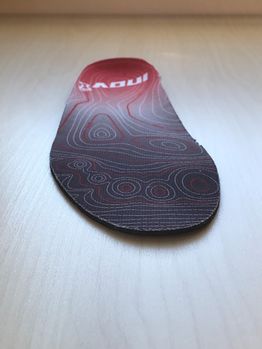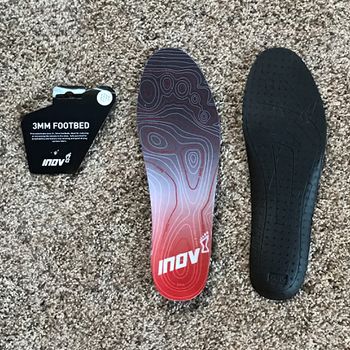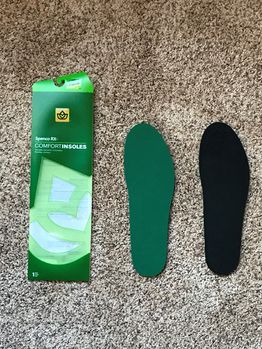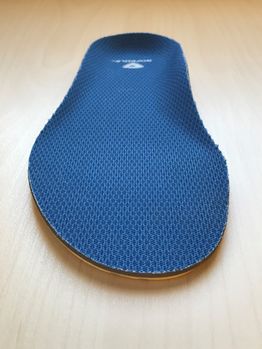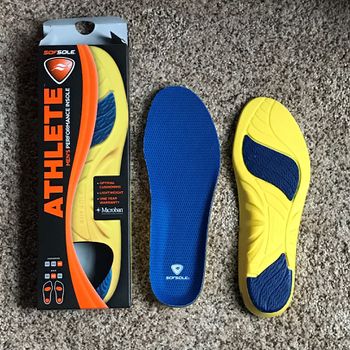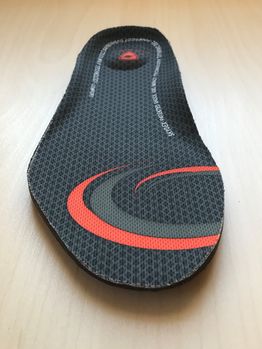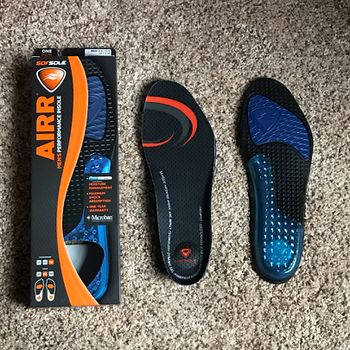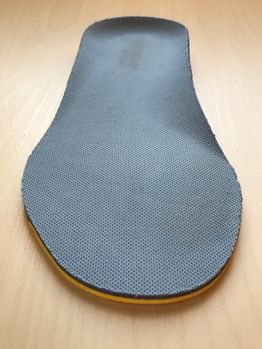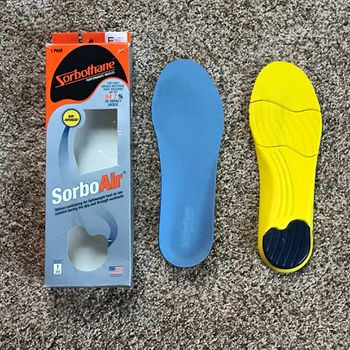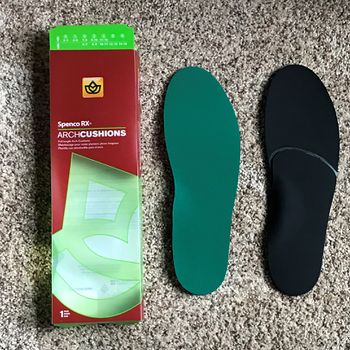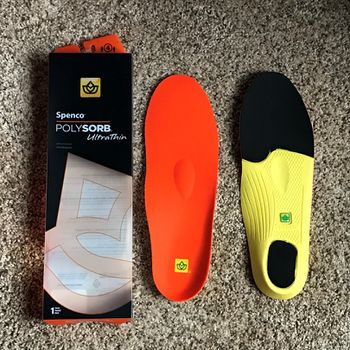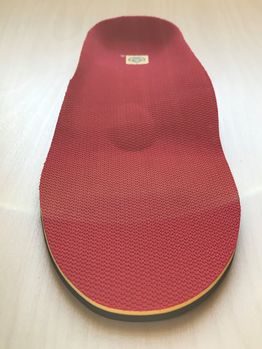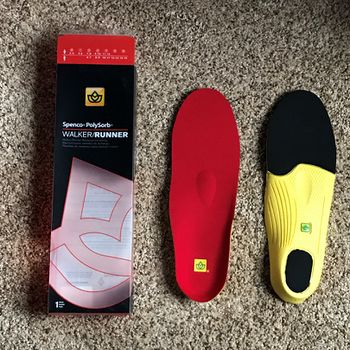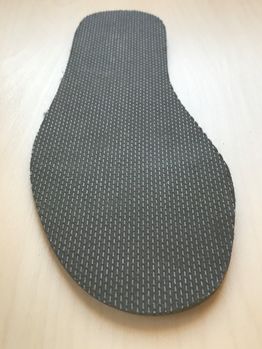Replacement Insoles For Running Shoes
I tested many different running shoes over the years, and with a few exceptions, I found that they don't lost anywhere near as long as I would hope. The main limit to the lifespan of a running shoe is generally the breakdown of the foam that results in less cushioning and more importantly uneven cushioning. This uneven cushioning tends to twist the foot in odd ways, and I suspect is a factor in running injuries. Most running shoes have their foam cushioning split between the midsole and the insole. The insole is one of the cheapest bits of a running shoe to make, and because it's next to your foot it's often made of softer foam to improve comfort. Unfortunately, this soft, cheap phone breaks down quickly, and can be a limiting factor in the lifespan of your running shoes. In most shoes the foam insole is removable and easily replaceable. Or at least, it would be easily replaceable if you could find a replacement! The problem with finding a suitable replacement insole is that most of the products on the market are sold as expensive "miracle cures" that attempt to modify your Running Form. I've tested a number of different replacement insoles with the goal of finding some that can extend the life of your running shoes when the original insole starts to wear out. I've also include a table of some sample insoles from shoes I've recently tested at the bottom of this page. It's important to know the thickness of your current insoles, as the replacements could change the way your shoes feel. The replacement insoles could increase or reduce the amount of drop, which may or may not be desirable. They could change the shape of the arch; an arch is a naturally strongly structure unless you push up from underneath. I'm concerned that "arch support" quotes can irritate the foot and cause plantar fasciitis issues. The other obvious issues to look out for are the overall thickness which could increase or reduce the volume of your shoes, and the weight (most replacement insoles are likely to be quite a lot heavier than the originals.) I've also reviewed VKTRY Insoles, which use a carbon fiber plate to improve Running Economy, but I don't consider them a replacement insole in the way the other products reviewed here are.
Contents
[hide]1 What I Look For
The primary goal of this review is to find a simple replacement for most original insoles. Generally, I'm looking for something close to the original, rather than an upgrade. However, I was also curious about the possibility of a more expensive insole actually improving a running shoe. Most of the products I tested claim to be an improvement over the original, something that I found was rarely borne out in practice.
2 How I Tested
I tested the insoles below in a number of different shoes to see how they perform in different styles and shapes. I used the Saucony Freedom, Topo Fli-Lyte, and Hoka Clifton as my main test mules. While I sometimes ran with the same replacement insole in both shoes, I mostly ran with different insoles for comparison. Sometimes this would be the original insole and a new replacement, and sometimes 2 different replacement insoles. I found it surprising how some of the insoles interacted with particular shoes, and how sensitive some of the insoles are to the exact positioning within the shoe.
3 Overview
| Insole | Link | Rating | Size tested | Weight (oz) | Forefoot | Heel | Drop | Arch Peak | Arch Edge | Lateral Edge | Arch Bulge | Color |
|---|---|---|---|---|---|---|---|---|---|---|---|---|
| Inov-8 3mm | Error: Could not parse data from Amazon! | 5 | 11.0 | 0.7 | 3.0 | 4.4 | 1.4 | 4.2 | 1.8 | 3.5 | 0.7 | Contour red/black |
| Inov-8 6mm | Error: Could not parse data from Amazon! | 5 | 11.0 | 0.7 | 4.5 | 5.7 | 1.2 | 5.2 | 3.1 | 4.9 | 0.3 | Contour blue/red |
| Spenco RX Comfort Insoles | Error: Could not parse data from Amazon! | 4 | 10.0-11.0 | 0.9 | 3.4 | 3.4 | 0.0 | 3.4 | 3.4 | 3.4 | 0.0 | Green |
| Sof Sole Athlete | Error: Could not parse data from Amazon! | 2 | 9.0-10.5 | 2.2 | 6.1 | 8.0 | 1.9 | 10.4 | 3.8 | 8.9 | 1.5 | Dark Blue |
| Sof Sole Airr | Error: Could not parse data from Amazon! | 2 | 9.0-10.5 | 2.6 | 6.7 | 12.0 | 5.3 | 11.0 | 7.0 | 8.2 | 2.8 | Black+Stripes |
| Sorbothane Sorbo Air | Error: Could not parse data from Amazon! | 2 | 9.5-10.5 | 3.4 | 4.8 | 6.7 | 1.9 | 8.1 | 6.0 | 7.2 | 0.9 | Light Blue |
| Spenco RX Arch Cushion | Error: Could not parse data from Amazon! | 1 | 10.0-11.0 | 1.3 | 4.5 | 5.3 | 0.8 | 11.8 | 6.7 | 5.6 | 6.2 | Green |
| Spenco ProForm UltraThin | Error: Could not parse data from Amazon! | 1 | 10.0-11.0 | 2.0 | 4.7 | 5.8 | 1.1 | 10.2 | 6.6 | 6.5 | 3.7 | Orange |
| Spenco Poly Walk/Run | $25 At Zappos | 1 | 10.0-11.0 | 2.8 | 6.0 | 3.1 | -2.9 | 11.2 | 9.7 | 7.4 | 3.8 | Red |
| Rx Sorbo Classic | Error: Could not parse data from Amazon! | 1 | 9.5-10.5 | 3.0 | 4.6 | 6.3 | 1.7 | 4.0 | 3.1 | 3.5 | 0.5 | Black |
The forefoot and heel are in mm measured from the ball of the heel and ball of the forefoot, with the drop being the difference. The arch peak is the thickest part of the insole in the arch area. The Arch Edge is the thinnest part of the insole on the inside of the arch area; if this is too thick it may rub. The lateral edge is the thickness on the outside edge of the insole opposite the arch. The arch bulge is then how much higher the arch peak is than the lateral edge.
4 Inov-8 Foot Bed
The Inov-8 insole (marketed as "Inov-8 Foot Bed") is by far the closest thing I found to a replacement for an original insole. This may not be surprising, given that it's the only one produced by a shoe manufacturer. The insoles are reasonably firm, providing only modest cushioning, so if your original shoes had a thick, soft insole you may find the inov-8 insoles a little lacking. However, in most shoes that I tried the Inov-8 insoles with, they were a remarkably close match for the originals. These insoles are also a remarkably good fit, with the rounded heel shape matching the shoes I tested with a nicely. I had no problem with these insoles interacting strangely with any of the shoes I tried the main, nor were they are especially sensitive to their exact positioning within the shoe. The Inov-8 insoles are available in 2 thicknesses; 3mm and 6mm. You might expect, as I did, that the 6mm is twice as thick as the 3mm and offers twice the cushioning, but you'd be sadly mistaken. If you look at the picture below, you'll find that the 6 mm insoles are not as 6mm thick all over, but have only sections that are thicker. And if you check the table above, you'll find that instead of being twice as thick they're only 50% thicker. The good news is that the 6mm insoles weigh exactly the same as the 3mm insoles. I found the two thicknesses to be indistinguishable when running, and I couldn't even tell a difference in the remaining shoe volume. These insoles provide 1.2-1.4mm of drop, so take that into account. Your original insoles could have more or less drop than these insoles provide. The Inov-8 insoles are one of the cheapest I found, and I highly recommend them to extend the life of a running shoe with a degraded insole. The biggest problem I found with these insoles is getting hold of them, especially the 6mm version. The Inov-8 insoles ended up being my top pick, but the Spenco RX Comfort below came very close.
5 Spenco RX Comfort Insoles
The Spenco RX Comfort insoles are extremely simple. They are a completely flat piece of foam cut into the shape of an insole. There is no variation in sickness, nor is there any shaping of the insole to improve the fit. This is something of a mixed blessing; there is no bulge under the arch or attempts to interfere with your Running Form, but there's also no attempt to make it fit into the shoe properly. Most insoles have a cupped heel to prevent the insole sliding side to side, and they also taper at the edge all the way around. In practice, I had no problems with these deficits, but we could see the non-tapered edge rubbing for some runners. The Spenco RX Comfort insole is a little better cushioned than the Inov-8 but are only fractionally heavier. Like any replacement insole, the Spenco RX comfort may change the drop of your shoes. Because of these insoles are completely flat, they are more likely to reduce the drop than other insoles listed here. These insoles would probably be my top pick were it not for my concern about them rubbing for some runners.
6 Sof Sole Athlete
The Sof Sole Athlete insole has two different types of cushioning material. If you look at the picture below, the blue inserts are softer than the surrounding yellow foam. This makes the Sof Sole Athlete very sensitive to how it's positioned in relation to your foot and how it interacts with the shoe. Sometimes it will feel like there's a hard Medial Post just in front and to the inside of the ball of your heel, but other times this isn't noticeable at all. Likewise, the blue insert into the forefoot can sometimes feel very intrusive and uneven, and other times it will seem fine. Repositioning the insole slightly can help adjust this, but mostly it seems to be how the insole fits within the shoe. The Sof Sole Athlete insole is quite a bit heavier than a stock insole, but if you can get it positioned right it also adds a fair bit of cushioning. These insoles don't push up noticeably under the arch, though obviously that will depend largely on the shape of the shoe you're putting them in. The soft blue patches are also distinctly sticky, which helps them stay in place once you've got them positioned correctly. I think that the the Sof Sole Athlete is worth considering as it's a little better cushioned than the Spenco RX Comfort and it may work for you and your shoes.
7 Sof Sole Airr
The Sof Sole Airr is somewhat similar to their "Athlete" insole above. The Aiir has a similar blue forefoot inset that you can see in the picture below. The larger forefoot insert makes the forefoot a little less uneven than the Athlete insole, though I still had issues in some shoes. Unfortunately, the rear of the Airr is rather more complex, and rather more sensitive to positioning. If you look at the photo of the underside, the large blue insert appears to be a hollow, air filled pocket, perhaps a little like some of the Nike Air shoes. The rear of this insole has another complexity that you can see as a bump on the sidelong view of the top of the insole. This bump and the cushioning below it are made of rather softer material than the rest of the insole, so what appears to be a bump is actually a hole in practice. If the ball of your heel is positioned perfectly, then this feels like it's a softly cushioned insole. If your heel is not positioned quite right, then the rear of this insole feels anywhere from rather funky to distinctly uncomfortable. The Sof Sole Airr also has quite a lot of drop, though if you can get your heel positioned right a lot of that drop will disappear. I think this insole could work okay, but I'd urge caution. In my testing, I found the Sof Sole Athlete had more cushioning than this insole, so I'd try that before the Airr.
8 Sorbothane Sorbo Air
The Sorbothane Sorbo Air is the heaviest of the insoles I've tested here, but it also provides a noticeable improvement in cushioning over most stock insoles. I'm not convinced that the extra cushioning justifies the weight, though there may be reasons why you don't simply start off with a heavier, better cushioned shoe. This insole is also fairly thick, so it's likely to reduce the shoe volume in most running shoes. The insole is made from Sorbothane which is a visco-elastic material that is good at absorbing vibration. One characteristic of Sorbothane is that it has a very little rebound, sometimes being described as being like a slice of meat. This means the Sorbothane has rather less bounce than a foam based insole, something that is undesirable for running.
9 Spenco RX Arch Cushion
The Spenco RX Arch Cushion is the Spenco RX Comfort Insole with a thick lump of foam under the arch. I found this uncomfortable, and I found it irritated my plantar fascia, and I generally recommend avoiding any footwear that pushes up under the arch. If you can't get the Spenco RX Comfort Insole, then it's quite possible to cut out the arch bump and have an insole that is virtually the same as the Comfort. If you really want an insole that pushes up under the arch of your foot, then this is a less bad option than either the Spenco ProForm UltraThin or Spenco Poly Walk/Run below.
10 Spenco ProForm UltraThin
I really disliked running in the Spenco ProForm UltraThin insoles. The bump you can see in the photo of the top of the insole taken from an angle is intended to help deal with a Mortons Neuroma by spreading the metatarsals. I found it was completely ineffective, and if you look at the underside you can see that instead of being a lump at this point it is actually just a pressed up a bump, so it collapses flat when you're wearing it. My biggest problem however was the "arch support" which was not only horribly intrusive, but seemed horribly placed. Instead of pushing up evenly under the arch it seemed to push up only under the midline of the foot, and failed to push up under the inside edge of the arch. I could only run a relatively short distance before this insole started to trigger plantar fasciitis, something I have had occasional issues with.
11 Spenco Poly Walk/Run
The Spenco Poly Walk/Run is a worse version of their "ProForm UltraThin" reviewed above. It's heavier, and the arch problems are even worse.
12 Rx Sorbo Classic
I expected to like the Rx Sorbo Classic insole, as it is fairly flat and I thought the Sorbothane material would provide good cushioning. Instead, this insole provides a good example of why nobody uses Sorbothane in a running shoe. The Sorbothane provides relatively little cushioning, combined with a rather "dead" feeling due to the lack of any type of bounce, and to add insult to injury it's also rather heavy.
13 Sample OEM Insoles
Here are a few insoles from shoes I've tested to give you a sense of what a "normal" insole is like.
| Size tested | Weight | Forefoot | Heel | Drop | Arch Peak | Arch Edge | Arch Bulge | |
|---|---|---|---|---|---|---|---|---|
| Topo Fli-Lyte | 10.5 | 0.6 | 4.7 | 4.5 | -0.2 | 5.0 | 2.1 | 0.5 |
| Saucony Freedom | 10.5 | 0.6 | 4.2 | 3.8 | -0.4 | 3.9 | 3.7 | 0.1 |
| Asics GT 2000 | 10.5 | 0.7 | 4.3 | 5.8 | 1.5 | 6.0 | 2.8 | 1.7 |

